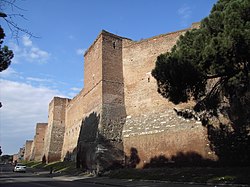Aurelian Wall
| Aurelian Walls | |
|---|---|
| Part of Rome | |
| Italy | |

A section of Aurelian wall between the Porta Ardeatina and Porta San Sebastiano.
|
|

Map of ancient Rome with the Aurelian walls (red) and its gates highlighted. The 4th-Century BC Servian Walls (blue) are also shown.
|
|
| Type | Defensive wall |
| Height | Up to 10 metres (33 ft) |
| Site information | |
| Owner | Italian Government |
| Open to the public |
Open to public. |
| Condition | Remaining sections: Either semi-ruinous or partly restored |
| Site history | |
| Built | 271-275 AD |
| Built by | Roman Citizens |
| Materials |
Concrete Brick Mortar |
| Demolished | Some parts in the Medieval Period |
| Events |
Sack of Rome (410) Sack of Rome (455) Capture of Rome |
| Garrison information | |
| Garrison | Praetorian Guard |
| Occupants | Romans |
The Aurelian Walls (Italian: Mura aureliane) are a line of city walls built between 271 AD and 275 AD in Rome, Italy, during the reign of the Roman Emperors Aurelian and Probus. They superseded the earlier Servian Wall built during the 4th century BC.
The walls enclosed all the seven hills of Rome plus the Campus Martius and, on the right bank of the Tiber, the Trastevere district. The river banks within the city limits appear to have been left unfortified, although they were fortified along the Campus Martius. The size of the entire enclosed area is 1,400 hectares (3,500 acres).
The full circuit ran for 19 kilometres (12 mi) surrounding an area of 13.7 square kilometres (5.3 sq mi). The walls were constructed in brick-faced concrete, 3.5 metres (11 ft) thick and 8 metres (26 ft) high, with a square tower every 100 Roman feet (29.6 metres (97 ft)).
In the 4th century, remodelling doubled the height of the walls to 16 metres (52 ft). By 500 AD, the circuit possessed 383 towers, 7,020 crenellations, 18 main gates, 5 postern gates, 116 latrines, and 2,066 large external windows.
By the third century AD, the boundaries of Rome had grown far beyond the area enclosed by the old Servian Wall, built during the Republican period in the late 4th century BC. Rome had remained unfortified during the subsequent centuries of expansion and consolidation due to lack of hostile threats against the city. The citizens of Rome took great pride in knowing that Rome required no fortifications because of the stability brought by the Pax Romana and the protection of the Roman Army. However, the need for updated defences became acute during the crisis of the Third Century, when barbarian tribes flooded through the Germanic frontier and the Roman Army struggled to stop them. In 270, the barbarian Juthungi and Vandals invaded northern Italy, inflicting a severe defeat on the Romans at Placentia (modern Piacenza) before eventually being driven back. Further trouble broke out in Rome itself in the summer of 271, when the mint workers rose in rebellion. Several thousand people died in the fierce fighting that resulted.
...
Wikipedia
